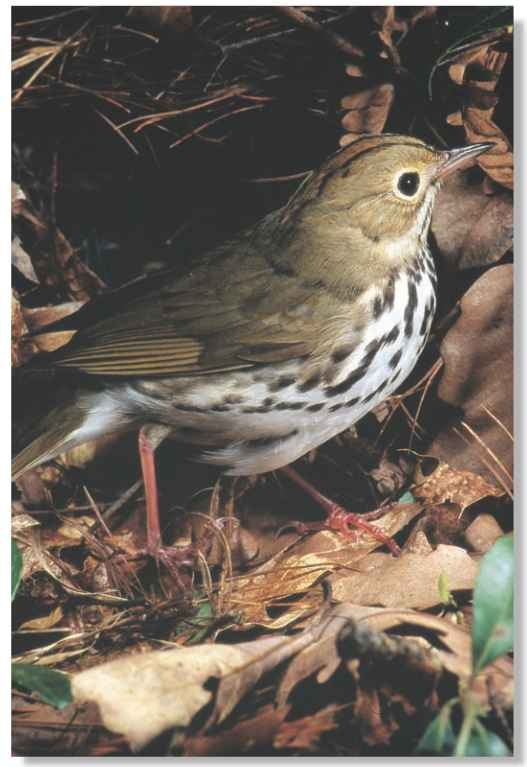ORDER
Passeriform.es
FAMILY
Parulidae
GENUS & SPECIES
KEY FEATURES
• Easily identified by
its unusual walking gait and carriage; its tail
tilts upward and wings droop slightly
• Takes its name from
the shape of its nest, [ which looks like an old-I fashioned Dutch oven
• To lure predators away from its nest, the female ovenbird will flutter away with wings and tail dragging as if mortally wounded
WHERE IN THE WORLD?
; Found across North America, north to Newfoundland and Alaska; west to the f Rockies; south to I the West Indies and \ Bahamas; abundant in I Florida, South Carolina I and Louisiana

Lifecycle
The ovenbird stays close to the forest floor where it finds food and keeps its unusual oven-shaped nest well hidden among the beds of fallen leaves.
HABITAT
The ovenbird frequents forests where its natural camouflage blends in best. Deciduous and mixed forests both suit the ovenbird, which breeds in the Canadian northwoods and in the northeastern U.S. During fall and winter, the ovenbird migrates to Mexico, Central America and as far south as Venezuela, but it is frequently spotted in winter in the far southern reaches of the U.S.
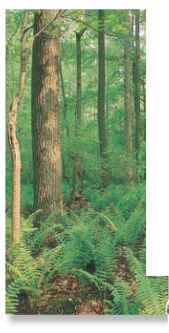
A Serene scene The ovenbird prefers forests with lots of shade and leaf litter.
Female ovenbirds are so reluctant to leave their ground nest containing young that they end up getting stepped on rather than fleeing.
During a 48-hour period, a noisy ovenbird sang 215 times, more than once every 13 minutes, day and night.
The genus name, Seirus, comes from the Greek “seio,” to move, and “oura,” meaning tail. The species name, aurocapillus, comes from the Latin words, “aurum” and “capillus,” meaning gold hair, referring to the ovenbird’s golden-orange crown.
FOOD & FEEDING
The ovenbird forages most of the day on the forest floor: It deliberately strides, with its high-stepping gait, across leaf litter and logs as it searches for tidbits. Throughout the day, the ovenbird is safely camouflaged in the cover of fallen leaves: The ovenbird turns over dead leaves to glean snails, earthworms, spiders and, on occasion, uncovers a small lizard or frog. In the fall and winter; it relies on fruit and other vegetation, since insects are scarce. The ovenbird’s bill opens seeds with ease. The ovenbird also consumes grit, used in the bird’s gizzard to help grind up food. The bird picks very little prey from live vegetation, but it occasionally will alight in trees to feast on tree snails or hatches of budworms found in spruce trees. The normally reclusive ovenbirds have even been seen at Everglades National Park feeding on table scraps left over from tourists.
Gobs of grubs
The inquisitive ovenbird leaves no leaf unturned and uncovers a mouthful of larval grubs.
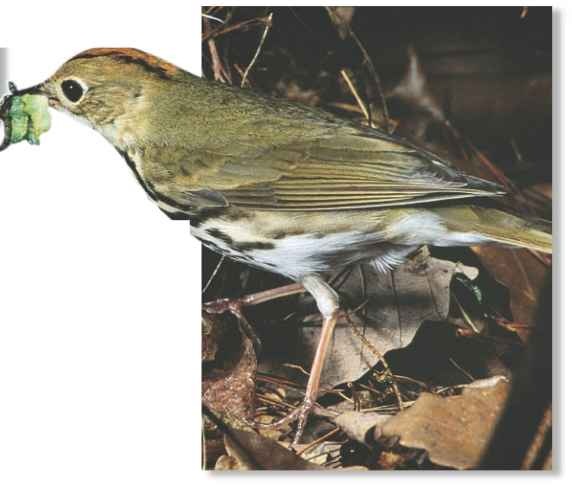
CONSERVATION
Ovenbird populations have been in decline for more than two decades, mainly due to habitat loss. The bird can be almost absent in tracts of 250-2,000 , acres. Radio towers and skyscrapers take a toll on migrating flocks.
BEHAVIOR
The call of the ovenbird, tea-cher, tea-cher, tea-cher, is a familiar sound during spring in the forests of the Northern U.S. and Canada. It also emits a warning cheep if it detects something approaching its nest. The ovenbird has a distinctive walk. With its tail up, wings drooped and head bobbing, it is easily distinguished from other warblers as it crosses the forest floor. Its coloring provides such effective camouflage that it can wait until the last moment to react to a threat. It migrates in flocks but is solitary outside the breeding season; some are permanent residents in the south.
Shades of brown The bird’s plumage blends with the forest floor.
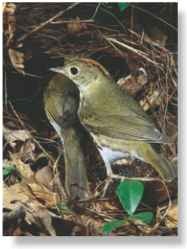
BREEDING
In spring, the male ovenbird arrives at its breeding grounds about two weeks earlier than the female. Once she arrives, he puts on an impressive aerial display, on occasion flying 20′ above her, circling and then making a downward flight. He then hops, struts and bows his head toward the female. If she accepts his attentions, they mate.The nest is made of leaves, stems, bits of moss and bark Hidden on the ground, it’s shaped like an old-fashioned Dutch oven (hence the bird’s name) with a shallow dome over the top and an opening on the side. When the nesting female is approached she occasionally will act if she is hurt, fluttering away from the nest to attract attention to herself. The ovenbird lays 3-6 creamy-colored eggs with brown spots. It must beware of the cowbird, which pushes aside an ovenbird egg and lays one of its own as a replacement. When this happens, the ovenbird raises the chick as her own.The hungry nestlings are fed insects dozens of times per day and fledge in 8-1 I days.

HOME SWEET DOME
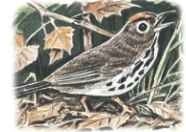
Call of the wild…
An ovenbird male sings its familiar song from the safety of the forest floor.
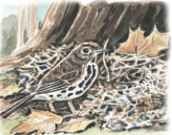
Under construction…
A female ovenbird uses twigs and leaves to build her oven-shaped nest in the deep beds of leaf litter.
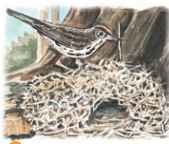
Over the top…
The female weaves the canopy covering the top of the nest, concealing it from predators.
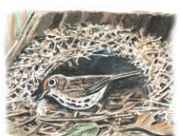
Finishing touches
With the dome finished, the nest’s lining is padded with plant stalks and even horse hair.
PROFILE
Ovenbird
The ovenbird’s distinctive song echoes through the woodlands while its natural camouflage keeps it well hidden on the forest floor.
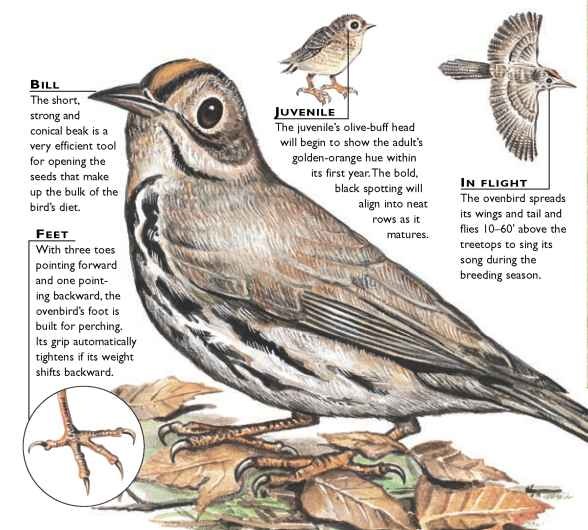
CREATURE COMPARISONS
Unlike most warblers, including the ovenbird, the Prothonotary warbler (Protonotaria citrea) is a cavity nester that makes its home in tree holes or other similar cavities. The Prothonotary warbler is also known as the golden swamp warbler because of its brilliant coloration and preference for damp, dark lowland woods as nesting sites. This warbler also favors wooded swamps, flooded bottomland forests and areas surrounding slow-moving water, in sharp contrast to the ovenbird, which nests mainly in dry, grassy areas.
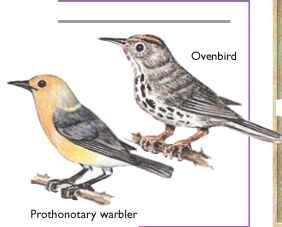
| VITAL STATISTICS Weight 0.5-1 oz. |
|
| Length | 5.75″ |
| Wingspan | 9-11″ |
| Sexual Maturity | 1 year |
| Breeding Season | May-July i |
| Number of Eggs | 3-6, usually 4-5 |
| Incubation Period | 11-14 days |
| Fledging Period | 8-11 days |
| Breeding Interval | , 1 year |
| Typical Diet | Seeds, snails, earthworms, insects, spiders, fruit, lizards and frogs |
| Lifespan | 8 years |
RELATED SPECIES
• The ovenbird is one of only three species in the genus Seiurus. The northern waterthrush, S noveboracenis, has a similar gait to the ovenbird, but prefers streams and pools. The Louisiana waterthrush, S. motacilla, also tends to live near streams. The order Passeriformes includes 46 families of perching birds, such as broadbills, larks, warblers and honeyeaters.
